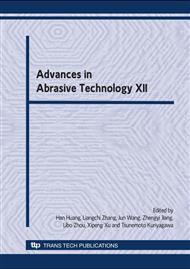p.149
p.155
p.163
p.169
p.175
p.181
p.189
p.195
p.201
Estimation of Dressing Effects in Chemical Mechanical Polishing with Sorts of Diamond Dressers
Abstract:
Chemical mechanical polishing (CMP) is a semiconductor process that is used to achieve global planarization. To maintain the stability and the throughput of CMP, the polishing pad needs to be dressed by a diamond dresser. By calculating the distribution of the scratch numbers of diamond grits in the pad, the effect of dressing can be estimated and the pad profile can be predicted. All the parameters of dressing motion were taken into account. The target equipment of this study is Mirra Mesa, which is manufactured by Applied Materials. Different types of dressers, including ring-types and full-type, different pitches and arrangements are used in CMP process. Each of them was simulated in this study. The diamond pitch is relative to the number of diamonds and the scale of the total scratch time, but does not affect the profile of the scratch time. Regular or random arrangement makes no difference in the profile of the scratch times. The width of the ring influences the number of diamonds and the scale of the total counts while the profiles remain similar.
Info:
Periodical:
Pages:
175-180
Citation:
Online since:
June 2009
Authors:
Price:
Сopyright:
© 2009 Trans Tech Publications Ltd. All Rights Reserved
Share:
Citation:


